by Winding Pathways | Jun 6, 2024 | (Sub)Urban Homesteading, Nature
Gotta Love Media Hype
Just as the summer camping season began our local newspaper ran a story about dangerous animals. Snakes, bears, and mountain lions. It was scary enough to keep anyone out of the woods or campsite.
Are they really dangerous? Well, we’ve been tromping through woods, deserts, wetlands, canyons, and mountains for nearly 70 years in places where these animals sometimes lurk. Here’s what we have learned and had confirmed by “experts” on how to avoid confrontations with them.
Mountain Lions
Over years of hiking and camping in Idaho, Colorado, Arizona, New Mexico, and South Dakota mountain lion range we’ve never seen one. The odds of encountering a lion are minuscule. If one is around, it’s likely hiding or beating a hasty retreat. People are dangerous, by the way.
According to the Mountain Lion Foundation, the odds of being fatally attacked are about one in a billion, or longer odds than winning a billion-dollar lottery. Still, there have been seven fatal attacks in the past 25 years. Our advice: Odds of seeing a lion are amazingly unlikely but if one is spotted, stay a long way away.
Snake Adventures
We’ve unwittingly walked right past rattlesnakes in South Dakota, Idaho, and Iowa, and once spotted a copperhead near our tent in southern Missouri, but we’ve never been threatened by a poisonous snake. But we have had a few snake adventures.
Little Shovel Gets the Job Done
Once, when our family lived in Florida, Marion’s mom hollered for us kids to get inside. She rarely hollered so we did. Then, she told the older kids to get the neighbor. She had been hanging clothes when a coral snake wandered by. Mom, at all of 4’10” grabbed a huge shovel and pinned the snake in the sandy soil. Our neighbor came over with a little toy shovel, chopped up the snake, and pitched it into the wood pile. The very one where we used to sit in and eat oranges after playing in the orange grove. We found a new place to sit.
Billy Goat Gruff Adventure
When we were new to Iowa Byron Arnold, then a science teacher at Washington High School in Cedar Rapids, took us rattler hunting. Just to see them, not to hurt them. Byron and Rich took off with long strides while Marion, with shorter legs, and curiosity about the emerging wildflowers lingered. Realizing she’d lost sight of the guys, she hopped onto a large flat rock to be greeted in “Billy Goat Gruff” style by a timber rattler underneath inquiring, “Who’s that walking on my rock roof?” Yipes! Now what? Backing up to the far edge, she used her best movement science technique of the running LONG jump off the rock and sprinted across the stone-littered open woods. BTW, the guys had walked right past that rock and never disturbed the gentlemanly timber rattler.
Aptly Named Park In South Dakota
When camping at Snake Creek Campground in South Dakota on a boiling hot summer day, we decided to walk widely mowed paths to the beach. The name of the park is aptly named. Usually, we walk side by side. That day we were going single file when Marion spotted an unusual shape on the edge of the path. A prairie rattler is known to be mean. She called to Rich to watch out. He then stepped closer for a better look. GAAK! The snake kindly retreated. We took the long road back to the tent and slept uneasily that night.
Stay Away From the Sharp End
At an Outdoor Writers Conference years ago, a dog handler who trains hunting dogs to stay away from the sharp end of the snake calculated that for every snake people actually see on a ramble, they have likely passed dozens of unseen snakes over their hiking years. Snakes avoid confrontation. Because people are dangerous!
Snake Facts
According to the University of Florida, the odds of being bitten are about one in 37,500. The chart on the webpage reveals the thousands of people who die from lung cancer and auto accidents. But people still smoke or live in polluted areas and drive cars. So why are we freaked about snakes? Publicity.
With modern antivenoms, very few people die of snakebite. Most bites occur when people handle or molest a snake. Our advice: Watch where you step or put your hands (i.e. if rock climbing in snake country). If you spot a snake, stay away from it. Never attempt to irritate it or pick one up.
Bear Stories
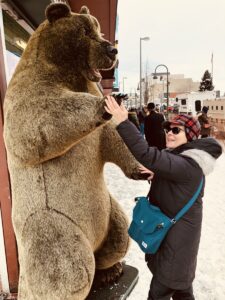
Close up with bears
Now, Bears are a different story. They range through most of the country but usually stay out of sight and away from people. And there are exceptions. Rich’s cousins tell a hilarious story of a bear climbing into the New Jersey suburban home, helping itself to kitchen goodies, and leaving its paw print on the wall as it left, all while the cousin and aunt huddled in the bedroom. Where was their cell phone? In the kitchen!
Friends of Marion’s in New Hampshire have bear adventures we’ve blogged about on Winding Pathways. And, in suburban New Jersey bears are routinely sighted at Cedar Lake. Marion has not been fortunate to see one, because she always smokes a stinky cigar from Denville Smoke Shop – obviously, this tactic works as bear repellent.
But, bears ARE around in suburban areas.
-
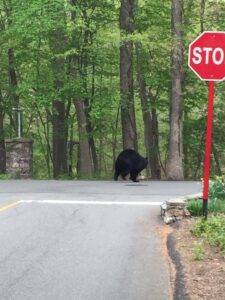
-
Suburban NJ has some prolific and big bears.
-
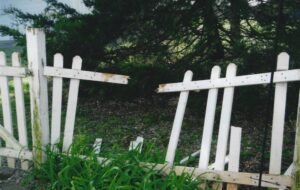
-
Picket fence torn apart by a hungry spring-time bear.
-
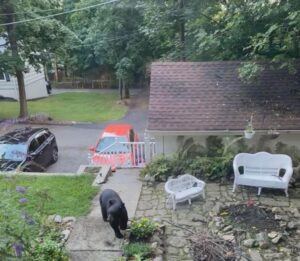
-
Bears make themselves at home anywhere.
Bear Facts
According to the National Park Service, the odds of a park visitor being attacked by a bear are one in 2.7 million. They are spreading and can cause mischief. Our advice: Keep a clean camp. Never leave food or other alluring objects with aromas (toothpaste, deodorant, perfumes in a tent. {why would one use any of these on a camp trip, anyway?} If a bear is spotted, stay a long way away, make noise, and slowly walk away from the animal.
What Animals Are Dangerous?
The best way to avoid trouble with any wild animal is to keep your eyes open and avoid conflict by staying a long way away.
Lions, snakes, and bears aren’t terribly dangerous but some animals are. Worldwide the most dangerous wild animal by far is the mosquito! According to the Advocates Injury Attorneys, the animals most likely to kill someone in the United States in order are:
- People. Homicides.
- Dogs.
- Deer. They don’t attack people. Deaths result from collisions with cars.
- Horses and Cows
- Bees, hornets, and wasps
At Winding Pathways, we encourage people to camp, hike, and enjoy the outdoors in their yards. Dangerous animals are not so abundant.
Threats posed by mountain lions, bears, and snakes are tiny and many can be prevented by using caution and common sense. Be cautious but go outside and PLAY!
by Winding Pathways | Jun 22, 2023 | (Sub)Urban Homesteading, Foraging, Mammals, Nature, Pests
Fish Camp Woes
This year a giant bear tore up the Popsie Fish Company’s camp near the remote Egegik River in Southwest Alaska before the salmon arrived. These huge brown bears are smart, hungry, and massively powerful.
Early Work on Salmon
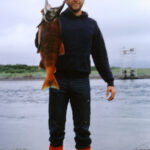
Good Catch
Early in his career, Rich was a salmon biologist for the Alaska Department of Fish and Game, working near the Egegik River. While there he loved eating the most delicious fish……. Sockeye Salmon.
During the summer millions of wild salmon of five species swarm into Bristol Bay but the sockeye is the most abundant. They are caught by many commercial fishing companies who net them in the bay and along beaches. State biologists ensure that enough fish survive nets to ascend rivers, spawn, and produce plenty of young to keep the runs robust.
Remembering Salmon Dinners

Fresh salmon is a treat.
Nearly a half-century ago he and Marion, co-owners of Winding Pathways, moved to the Midwest where there are no Sockeye Salmon. But they love grilling salmon fillets they order from the Popsie Fish Company. It catches, processes, and ships frozen fillets. The Pattersons occasionally order a box. In addition to being delicious and healthy, Alaskan Sockeye salmon are wild fish managed as a sustainable resource.
Bears on the Prowl
This year Popsie Owner Tony Neal had a problem. Like all commercial fishermen, he and his staff arrived well before the salmon run to set up their camp and prepare for fishing. That’s when the trouble arrived.
A brown bear tore its way into their building. Take a look at the photos to see what the bear did. It’s a mess.
-
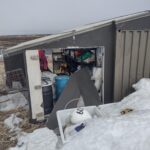
-
Bears are powerful. Photo Eric Handstad
-
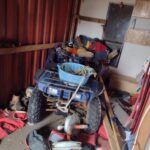
-
The work room is all shambles after a bear tore it up. Photo Eric Handstad
There is good news. There’s enough time before the salmon arrive to get everything fixed and ready to catch those delicious fish. To see Popsie Fish Company staff in action take a look at their website www.popsiefishco.com.
Increasing Occurrences of Bears
Iowans occasionally report a bear sighting, especially in NE Iowa where the woods make great shelter and rivers excellent corridors to travel.
Bears are increasing across the country even in urban areas. Past photos in papers have shown a bear walking down a major road near New York City. A recent newspaper article reported how a bear crashed into an Avon, CT, bakery and gobbled up 60 cupcakes before lumbering off. At Cedar Lake, Denville, NJ, a mama bear, and three cubs were recently spotted walking along the road. Actually, that is a fairly common sighting. Residents spread the word so walkers will be alert.
-
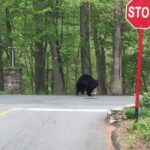
-
Suburban NJ has some prolific and big bears.
-
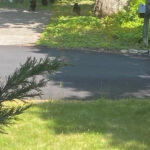
-
Bear and cubs. Photo Catherine Christ
The town police even fondly named one bruin “The Italian Bear.” Each night just after restaurants closed a fat bear would wander from its den, climb into the local Italian eatery’s dumpster, gorge itself, take a snooze, and come morning, climb out and go back to its secret den. Never hurt anyone.

SRF took this pix of a bear peering in the window.
In rural New Hampshire, friends have had bears visit the yard and peek into the house through the windows frequently.
First Person Story

Picket fence was torn apart by a hungry spring-time bear.
Jackie and Peter Hull in Bedford, Virginia, shared this first-person story of the spring adventures with an unruly bear. “Well, I got up bright and early one spring morning, peeked out the bedroom window and what did I see? A smashed six-foot piece of picket fence, a broken spindle on the front porch, and a shepherd’s hook bent to the ground.
“Lucky me I brought the bird feeders in last night. So now I know I can’t feed the birds anymore this year. This is the second year running when on Mother’s Day last year, a bear came and smashed the spindles on the porch railing and a different six-foot piece of fence.
“Later we found bear tracks in the red Virginia clay bordering the flower bed on the outside of the fence. It left its muddy red prints on the fence and the steps going to the side door of the house!
“What to do but repair the fence again, wash the feeders, and put them in the basement? I have decided to store the leftover bird feed in a large bag in the freezer for next winter.
“I will miss my “bird buddies” but I don’t what a 250+ pound bear in my house either. So, words to the wise, the same ones the ranger gave me last year, ‘Bring your feeders in now.'”
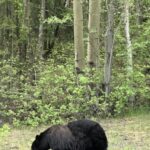
Alaskan Bear.
Back in Alaska, it is common even in suburban Anchorage neighborhoods to see a bear lumbering down a road. An Alaska-born, former Gazette editor spoke nonchalantly about bears and recess at schools. “We always had outdoor recess…except when a bear roamed the playground.”
Bears are about that is for sure!
by Winding Pathways | Sep 15, 2022 | (Sub)Urban Homesteading, Birds, Garden/Yard, Mammals, Nature, Pests
Guest Blog by Jackie Hull,
in the foothills of Virginia
Bears Barely Tolerable Behavior
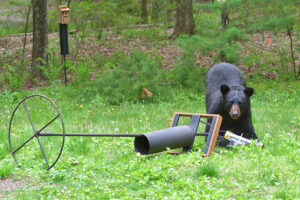
Bear Raiding Feeders
Well, the bear did it again. It tore up some of the spindles on the porch railing, tipped over a couple of the vegetable pots, and yanked a six-foot portion of our picket fence off the posts. All this to remind me that I should not feed the birds this time of year. It’s May.
So what to do but put away all the feeders? Maybe I can try again in the fall when bears retreat to the dens for their winter snooze.
This pretty much gave me great moments of sadness especially since I’ve had to shed other favorite activities.
Bird Antics Bring Joy
But today was a day of great surprises. My beautiful main stays, the birds, were everywhere. As I sat in the kitchen peering out the window, I spotted the adult turkeys poking their heads above the uncut hay. I could feel their parental thoughts “The coast is clear so keep scrambling forward.” The chicks were not seen but definitely there. A goldfinch zipped over them. Then I saw two wood thrashers near the holly tree scavenging for insects. Oh, my look how that crow struts!
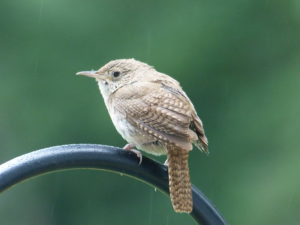
Wrens are Chatterers
Listen, that’s the wren by the back door. She keeps chattering to remind me she built her condo in the hanging planter. Then a flash of bright red caught my eye as I walked onto the porch. It’s a cardinal. Then the female house finch flicked from her nest over the front door light. She doesn’t like me stepping onto the porch. She is quite timid.
Even though the feeders have been down for nearly two months, the birds have kept their vigil at my country home much to my delight. They are in the trees, along the lane, and in the hayfield. What a great day!
by Winding Pathways | Oct 29, 2020 | Mammals, Nature, Reflections/Profiles
We settle into fall and sometimes like to just browse past stories. Here are some links to more recent Gazette features and natures notes.
Explore Iowa’s National Parks. August 2020
Take Advantage of Iowa’s County Gems July 2020
Why RV Life Isn’t for These Senior Tent Campers. July 2020
Bear Sightings in Iowa Getting More Common. June 2020
Take a Walk on the Wilder Side April 2020
Derecho Stories: Get Outside and Walk But Stay Safe September 2020, Rebirth Amid the Rubble September 2020
-

-
Overlook from Effigy Mounds
-
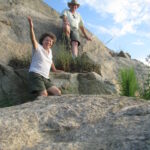
-
A near, fun place to walk and climb is Waldo’s rock.
-
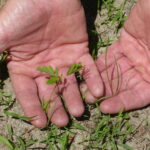
-
Prairie plant
-
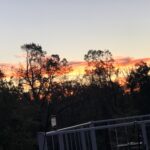
-
Sunrise on a changed landscape
-
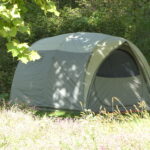
-
We have adjusted to getting older by using a larger tent and cots.
-
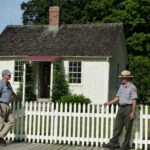
-
Herbert Hoover was Iowa’s only president.
-
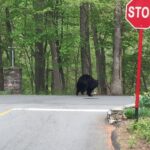
-
Bear sightings are more common in Iowa.
by Winding Pathways | Jun 29, 2017 | Mammals, Nature
A guest blog by Susan Fehsinger, New Hampshire
“I’ve spent most of my life in southern New Hampshire. Growing up, we never heard of bears being anywhere near our area, but their population has been growing rapidly. Now, we hear of them regularly. Our first live rural sighting was about 15 years ago. Since then, we either have seen them or evidence of them at least once a year.
“We live in the country on 16 acres and the nearest house is about 300 feet away across the road. There is plenty of bear habitat and they are becoming very common. Last year I was taking a walk along a class 6 road (a road that is not maintained any longer but is often used) when a black bear strolled up from the river and across the road about 30 yards ahead. I froze. S/he turned and looked at me for a long 10 or 15 seconds before continuing into the woods. Did I have my phone? Yes. Did I think to snap a photo? Nope.
“One morning this spring about 6:45, when the sky was fully light, I began to hear noises and thought our cat was running around upstairs. After a while, though, I looked out the window which opens onto our screen porch. Two bears were tearing into the stone retaining wall at its foundation. They were pulling out the seeds that the chipmunks had stored there. Both were fully grown and one of them was the largest I have ever seen in this area. The strangest part of this experience was that they didn’t spook at all. I called my husband and we both stood at the glass door taking pictures and talking.
“The population of our small town is growing, yet we are seeing more wildlife that used to be rare. I saw my first bobcat a year or so ago, also. It’s great to know that wildlife is doing well and large predators are around. We humans just need to be aware of potential danger — for us in case of a confrontation, and for them, if our behavior causes them to habituate to people. Fish and Game does not want to have to kill an animal that’s only crime is looking for food that we provide them.
“Beginning in early spring we are told to bring in bird feeders (and in my case stop using the screen porch as an extra refrigerator!) It’s definitely good advice because bears are excellent at finding any and all available food. Usually, the ones we see in early spring are females with cubs, and they can be very dangerous if a human gets between “mom” and her little ones. The fact that “my” bears were digging into a stonewall to get at seeds stored by chipmunks underlies how good they are at their job — feeding themselves and their cubs. We can learn to outsmart them, but they’ve been perfecting their food-finding skills for a long time and their senses are much better than ours. We have to become aware and vigilant so we can enjoy the fact that they’re here among us — just not too close.”
Check out these links below about
bears, habitat and behaviors. Many of these sites refer to “wild” places like parks and the North Woods. And, remember that the advice on respecting bears,
keeping your distance, and storing food all to avoid bear encounters is similar and are great tips for suburban and urban dwellers.
-
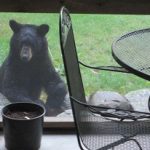
-
Bear Standing Up
-
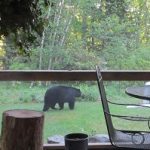
-
Bear moving off to the bird feeder.
























